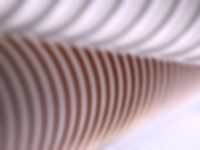
Materials for hose production
Learn more about our materials: Which materials are used in hose production and what are the advantages of each material? Here you can get an overview.
We process technically demanding plastics, fabrics and films into high-quality industrial hoses and innovative connection solutions.
We can draw on many years of experience in the field of polymer materials as well as fabrics and films and their processing. By processing modern materials, we realize solutions that can only be realized inadequately, at great expense or not at all with conventional materials. We have the necessary materials expertise to process these demanding materials into hoses and connectors that set international standards.

Plastics are versatile materials. An outstanding feature of plastics is that their technical properties, such as moldability, hardness, elasticity, breaking strength, temperature resistance, heat resistance and chemical resistance, can be varied within wide limits by the choice of starting material, manufacturing process and admixture of additives.
A large proportion of the hoses used to extract and convey abrasive solids are made of the high-performance material polyurethane (PUR). Polyurethane (PUR) is a modern, versatile plastic and offers an interesting combination of properties elasticity, resistance and aging resistance over a wide temperature range. In addition, the properties of PUR can be modified and adapted to specific operating conditions by adding additives. PUR is more flexible, more resistant and more abrasion-resistant to abrasive or aggressive materials and many chemicals. This increases the service life of products made of PUR. Unlike PVC, polyurethane is free of plasticizers. The vast majority of PU hoses are transparent, so that the material flow is visible and can be controlled.
Polyethylene is a thermoplastic and belongs to the group of polyolefins. Polyethylene is very durable due to its high resistance to acids, alkalis and chemicals and has a much higher chemical resistance than PU. The material has harder material properties than polyurethane. Polyethylene hoses are particularly suitable for demanding applications, e.g. for transporting aggressive gaseous and liquid media or for transporting fine-grained particles such as dusts and powders in the chemical sector. In particular, the PE material can demonstrate its excellent resistance to acetone, benzene, toluene and xylene.
PVC is one of the amorphous plastics. Nevertheless, this material is characterized by excellent media resistance. Hoses made of this material are suitable for almost any environment and for almost any application - unless solvents (aromatics, esters, ketones, CHCs) are used. PVC is an inexpensive, versatile material. However, the temperature resistance as well as the abrasion resistance of PVC are significantly worse than those of polyurethane. In addition, the material can become brittle over time due to migrating plasticizers, which can lead to premature hose failure.
The TPV hoses manufactured by Masterflex are produced from a thermoplastic rubber. TPVs belong to the group of thermoplastic elastomers, which excellently combine the performance properties of vulcanizable rubber, such as heat resistance and low compression set, with the ease of processing of thermoplastics.
A frequently used material for fully extruded plastic hoses is polyamide. Due to the large number of common PA variants, the designation of these is very complex. All the usual processes for thermoplastics are possible during processing. The various PA variants differ only slightly in their properties. PA is basically characterized by its very good sliding and wear behavior, dry running properties, insensitivity to dirt and resistance to chemicals. The classic areas of application for our PA hoses are mechanical engineering, robotics and automation, painting technology, automotive and many more.
Additives as a material supplement in hose production
Additives are substances that are added to a plastic to achieve certain properties. Additives can be, for example, lubricants, anti-blocking agents, antistatics, flame retardants, colorants, plasticizers, and many more. The specific applications of the individual additives can usually already be found in the additive name categories.
Antistatic agents are intended, for example, to reduce the electrostatic charge of a material. Flame retardens are intended to prevent the plastic from burning. Flame retardants can be added to the plastic through compounding or bonded directly to the substrate as reactive polymers. Colorants are insoluble pigments or, in the plastic only, colorants that are soluble in the plastic. They change the color of the plastic.
Fabric as a material for hoses

We are specialized in processing high performance fabrics. Our clip hoses, for example, are made from different types of fabric. The individual types of fabric differ from one another in terms of their properties. For example, there are particularly chemical-resistant fabrics such as PTFE, Viton, Kapton or Hypalon. Likewise, particularly heat-resistant types of fabric are processed, enabling use in the high-temperature range. The materials used are clamped together in a clip process by an external steel spiral to form hoses with high tensile strength. This process involves no welding, gluing or sewing. Depending on the external or internal stresses, the hoses can also be manufactured in multiple layers.






